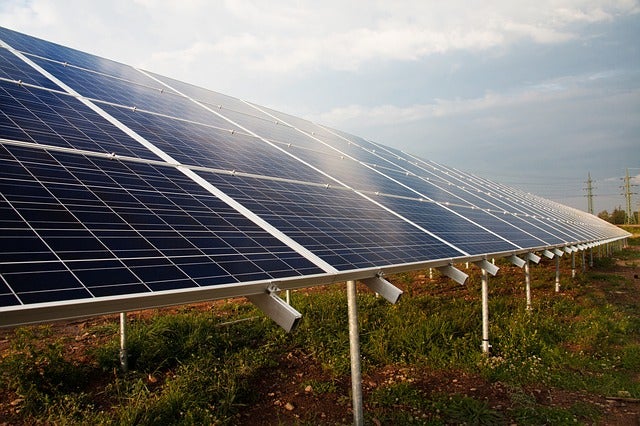
NS Energy lists the five largest solar energy producers in Asia based on their installed renewable capacity in 2018.
China -175GW
China is the largest producer of solar power in Asia. Solar power produced by the country accounts for more than 25% of its total renewable energy capacity, which stood at 695.8GW in 2018. China operates one of the world’s largest PV power stations, The Tengger Desert solar park, located in Zhongwei, Ningxia, with an installed capacity of 1,547MW.
The other major solar power facilities include the 850MW Longyangxia solar park on the Tibetan Plateau in northwestern China’s Qinghai province; the 500MW Huanghe Hydropower Golmud Solar Park; and the 200MW Gansu Jintai Solar Facility in Jin Chang, Gansu Province. In 2018, Trina Solar won a bid for the construction of ‘Top Runner’ 250MW solar PV power plant in Tongchuan, Shaanxi.

In March 2019, Chinese solar module developer LONGi Solar inaugurated a new 5GW monocrystalline module factory in Chuzhou, Anhui.
Japan – 55.5GW
Japan is the second largest solar energy producer in Asia. The country’s solar power capacity contributes to more than half of its total renewable energy capacity, which was 90.1GW in 2018. The country aims to generate about 24% of its electricity from renewable sources by 2030.
Some of the major solar facilities in the country include: the 235MW Setouchi Kirei Mega Solar Power Plant in Okayama; the 148MW Eurus Rokkasho Solar Park in Aomori owned by Eurus Energy; and the 111MW SoftBank Tomatoh Abira Solar Park in Hokkaido operated by a joint venture between SB Energy and Mitsui.
Last year, Canadian Solar has commissioned a 56.3MW solar project at a former golf course in Japan. In May 2018, Kyocera TCL Solar completed the construction of the 29.2MW solar plant in Yonago City, Tottori Prefecture. In June 2019, Total started commercial operations of a 25MW solar power plant in Miyako, in Iwate Prefecture on Japan’s Honshu Island.

India – 27GW
India is the third largest producer of solar power in Asia. Power generated by the country’s solar facilities account 22.8% of its total renewable energy capacity. Of the total 175GW targeted installed renewable capacity, India aims to have 100GW of solar capacity by 2022.
Some of the country’s biggest solar projects include: the 2GW Pavagada Solar Park, also known as Shakti Sthala, in Karnataka owned by the Karnataka Solar Power Development Corporation (KSPDCL); the 1GW Kurnool Ultra Mega Solar Park in Andhra Pradesh owned by the Andhra Pradesh Solar Power Corporation (APSPCL); and the 648MW Kamuthi Solar Power Project in Tamil Nadu owned by Adani Power.
The country will also boost its solar generation capacity following the commissioning of four phases of the 2.25GW Bhadla solar park, which is being built in Rajasthan’s Jodhpur district. Spread over 4,500 hectares, the solar park is reported to be built with an investment of $1.3bn (£1.02bn).
South Korea- 7.8GW
South Korea is ranked fourth among the top solar power producing countries in Asia. The country’s solar power is generated through a host of small and medium-sized solar farms of less than 100MW capacities.
In December 2017, South Korea embarked on a power supply plan to achieve 20% of its total power consumption with renewable energy by 2030. As part of it, the country is aiming to add 30.8GW of new solar power generating capacity.
Between 2017 and 2018, South Korea’s installed solar capacity jumped from 5.83GW to 7.86GW. In 2017, the country added nearly 1.3GW of new solar capacity.
In November 2018, South Korean President Moon Jae-in announced plans to develop a 3GW solar park at Saemangeum, which is aimed to be commissioned by 2022. The solar park called Gunsan Floating Solar PV Park or Saemangeum Renewable Energy Project will be an offshore project to be built in the North Jeolla province off the coast of Gunsan. The power generated by the Gunsan Floating Solar PV Park will be purchased by the Korea Electric Power Corp.

Thailand -2.7GW
Thailand is the fifth largest solar power producing country in Asia. Although, new solar generation capacity in Thailand has been more or less stagnant between 2017 and 2018, the South East Asian country has plans to reach the 6GW mark by 2036.
Currently, there are three solar facilities in operation in Thailand that have capacities of more than 100MW that include the 134MW Phitsanulok-EA Solar PV Park in Phitsanulok, the 128.4MW Lampang-EA Solar PV Park in Lampang and the 126MW Nakhon Sawan-EA Solar PV Park in Nakhon Sawan. All the three solar parks are owned by Energy Absolute Public.
The first major solar facility to be installed in Thailand is the 83.5MW Lop Buri Solar PV Park in the Lop Buri province. Owned by Natural Energy Development, the Lop Buri solar park has been generating power since 2012.
As per media reports, Thailand is bracing up to develop 16 floating solar farms with a combined capacity of over 2.7GW by 2037. The floating solar farms are planned to be built at existing hydropower reservoirs.






